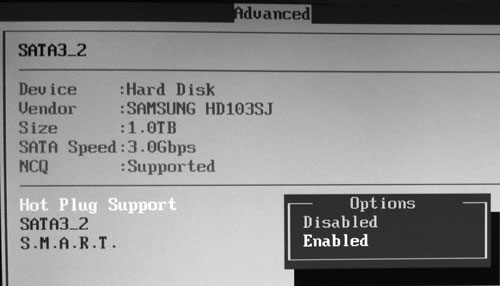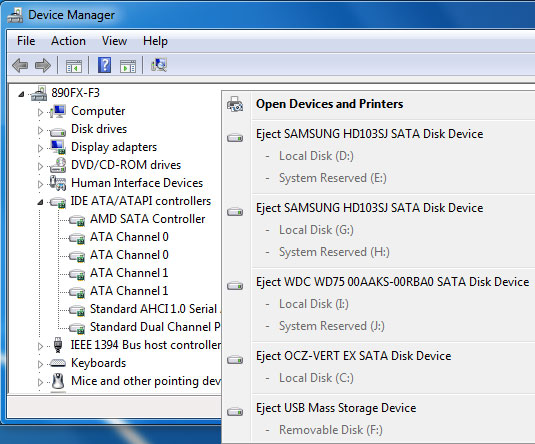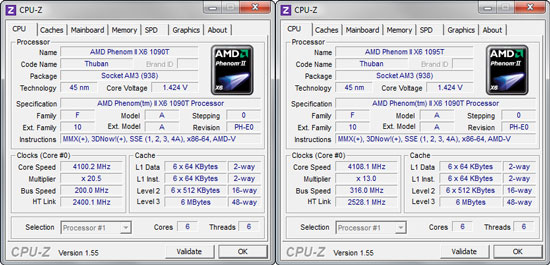ASRock 890FX Deluxe: Comprehensive Motherboard Review & Investigation of Thuban Performance Scaling
by Rajinder Gill on August 31, 2010 7:00 AM EST- Posted in
- ASRock
- AMD
- Motherboards
- 890FX
The Deluxe 4’s AMI-based BIOS is pretty straight-forward. Almost all overclocking related changes are made under “OC Tweaker” tab, and enthusiasts will feel right at home with familiar labels. We suggest you take a look at the Gallery for the individual pages of the Deluxe 4’s BIOS.
A notable item in the BIOS is the way ASRock manages SB850’s six SATA 6.0 Gbps ports as well as two of the Marvell’s. We’ve already commended how the Deluxe 4 matches the port numbers in the BIOS and on the PCB. Furthermore, ASRock somehow found a seamless way to make hot-plug/hot-swap to work from the BIOS, both for Windows native AHCI drivers and for AMD’s AHCI drivers. Windows and AHCI have had a rather tricky history, and although Windows 7 is miles ahead of previous iterations of Windows, we still run into trouble getting hot-plug function properly on occasions. Those who have attempted to take advantage of AHCI’s hot-plug/hot-swap might remember “Safely Remove Hardware” notification disappearing, or not showing up at all when it should. This often occurs upon installation of chipset drivers from AMD and Intel but Windows native AHCI drivers don’t seem to be immune to it, either.
The Deluxe 4 lets users handle this in the BIOS’s Storage Configuration section. Once AHCI is enabled, users can select individual drives to enable hot-swap/hot-plug. This worked for us with Microsoft’s AHCI drivers, AMD’s AHCI drivers, and with the “F8” method by loading the AHCI drivers at the time of OS installation. We are not sure how ASRock is doing this but it worked throughout our testing with both SSDs and mechanical drives, so we have no complaints.


Our retail 1090T CPU reached its maximum overclock of 4.10 GHz on the Deluxe 4 at 1.42V actual vCore using conventional air-cooling. Having a Black-Edition CPU makes overclocking easy on most boards if you simply want to take advantage of the unlocked multiplier. On the 890FX Deluxe 4 or any other board, our retail 1090T’s overclocking has been limited by heat for the most part. For maximum HTT overclocking, we lowered multiplier as low as x10 and reached 316 HTT, which coincidently got us to the same maximum CPU overclock of 4.10 GHz using x13 multiplier. For S3 Sleep/resume to work correctly the HTT had to stay at or below 290 HTT. Not bad, but not great. That should give enough room for the 1055T CPU (x14 multi) to reach its maximum potential, but it might not be enough for CPUs with lower multipliers. (There are rumors of more X6 CPUs from AMD later this year).

In general, the board tends to overvolt vCore under load by 0.04V with ensuing 0.02V or so vDroop. For example, when we set the vCore to 1.40V, the CPU received about 1.44V when the load is light (e.g. a single Super Pi instance), but when all 6 cores were loaded fully we measured about 1.42V. Once the CPU was idle and C1E kicked in, the board lowered the vCore below 1.20V accordingly.
Unfortunately, we found neither the BIOS reading nor Windows-based software including ASRock’s own OC Tuner utility correctly informs us of the actual amount of current the CPU receives. To make matters worse, the BIOS labels referring to vDroop control are highly misleading. The BIOS offers four options under “Load-line Calibration” section: Auto, Normal, Slight, Disable. We advise you to stick to “Normal” if you overclock, and to “Auto” for stock operation with TurboCore enabled, since the other two options will take your CPU to a voltage rollercoaster. “Normal” was also the most predictive of all as we exampled above, so without reliable software readings it is the only option we would take when overclocking an X6 CPU.
Memory overclocking on the Deluxe 4 was disappointing compared to our experience on ASUS M4A89GTD Pro/USB3. First and foremost, we warn you again the board overvolts memory by 0.05~0.06V so you should always subtract what you set in the BIOS by that amount. We set out to find out maximum stable frequency using 4 x 2GB and reasonable timings, and settled at DDR3-1666/7-8-7-1T at vDIMM set to 1.62V actual (1.57V in the BIOS). It was possible to run DDR3-1666/7-7-7-1T but it required us to set 1.62V in the BIOS, resulting in actual 1.67~1.68 vDIMM. The maximum frequency we reached with complete stability on 8GB configuration was DDR3-1800/8-9-8-2T. 4GB configuration with two DIMMs did fare slightly better, reaching stable DDR3-1800/7-8-7-1T. We were able to finish some tests @DDR3-2000/8-9-8-1T (1.67V actual), but it was nowhere near fully stable to finish our entire stressing test suit.
Overall, we feel the Deluxe 4’s memory overclocking is rather limited; the BIOS provides no control options for certain sub-timings that require adjustment as memory frequency is increased. This is obviously a matter of BIOS finesse, since we were easily able to achieve DDR3-2066/8-9-8-1T on the ASUS M4A89GTD USB3/PRO, using the same 4x2GB PSC kits. We hope ASRock will improve in this regard in the future BIOS releases, so that users will have more freedom exploring the limits of their hardware.
















42 Comments
View All Comments
Kane Y. Jeong - Tuesday, August 31, 2010 - link
Anand has already covered SB850 in depth, so I linked to the article.http://www.anandtech.com/show/2973/6gbps-sata-perf...
Said that, I will get back to you after contacting ASRock as to your question. Thank you.
poohbear - Wednesday, September 1, 2010 - link
that article doesnt address how TRIM is disabled w/ the AMD drivers. It might increase performance, but with TRIM disabled it makes the SSD have terrible performance in the long term. Please bring this up in AMD chipset reviews as AMD is just ignoring the issue. its a mess.Slaimus - Wednesday, September 1, 2010 - link
Are you talking about the RAID driver passing TRIM to the individual drives in the array? TRIM in general is working AFAIK.stuartrue - Tuesday, August 31, 2010 - link
Do the AMD AHCI drivers support the TRIM command?DWeber - Tuesday, August 31, 2010 - link
Love the extent of your articles. Clean written, good facts, interesting NB-Frequency benches.But what the f* is a Radeon HD 5780?
Egap19 - Tuesday, August 31, 2010 - link
Thank you for the throw review, but if it's first 890fx review why not asus or gigabyte? Heck MSI there too. Do a round up or something. AMD gets no love around here.BestBuyJock2 - Tuesday, August 31, 2010 - link
I love the StarCraft 2 bench. It was an eye opener. I only have an Athlon X4 but I may test the same thing. Very informative review rarely seen these days. Thank you Anandtech!cousin2003 - Tuesday, August 31, 2010 - link
cousin2003; Very impressive article. Is the Motherboard available yet. I really learned about more about Thuben CPU's. Thank you.najames - Tuesday, August 31, 2010 - link
It is rumored that AMD 890FX boards will allow passthrough hardware in virtual machines like Intel VT-d with some "updated BIOS", meaning a graphics card or video capture card and USB devices could be assigned in a VM. It would be nice if someone can verify this.I have briefly tried this with my Gigabyte X58-UD4P BIOS 13 and i7920 setup. It shows a virtualization option in the BIOS but Vsphere (ESXi 4.1) still shows it as unavailable. There is however a Beta BIOS I have not tried yet.
This seems to be a voodoo hit or miss on desktop computers although support goes back to the Q35 era desktop boards and servers.
beretta2013 - Tuesday, August 31, 2010 - link
You mentioned reaching 4.1Ghz on the 1090T, was that at idle in CPU-z validator or was that under full load in prime95? My $95 GA-770TA-UD3 can validate at 4.4GHz but 3.9 is the max stable clock speed. As far as wattage being pulled, my 1090T @3.8 & 1.42v draws 177watts itself under peak load in prime95; as quoted by the Gigabyte Energy Saver app. Cheers.